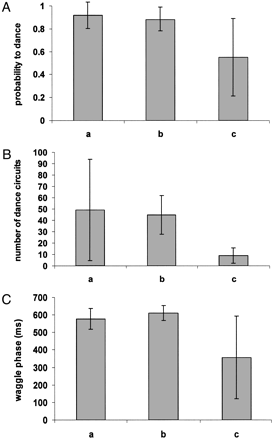Dance Bee Dance
Biology 342 Fall 06 A. Mahan
| Home | Phylogeny | Ontogeny | Mechanism | Adaptive Value | References | Course Home |
Ontogeny
Dancing behavior is dependent on learning capabilities.
Younger bees are unlikely to use the dancing behavior since potential foraging bees remain in the hive for 2-3 weeks after pupation. Before developing into a forager, a young bee may help care for young, fill and seal food storage combs, or help regulate hive temperature by either fanning water stores in warm weather or producing heat with muscle vibrations in cool weather. Once the bee is a few weeks old, it will likely leave the hive to forage and only then will it begin using the dancing phenotype (Tautz 2003).
Work done by Tautz, et al in 2003 showed that the development of the dance behavior is dependent on environmental cues and the ability to learn. Previous work established that temperature during the pupal stage has important effects on insect development, so investigators subjected pupae to different temperatures and then analyzed the effects on dance behavior when they reached adulthood.
To elucidate the most likely cause of this effect, investigators observed whether temperature also affected the bees' ability to learn. Bees can be conditioned to respond to a given stimulus by extending their feeding probiscus if they are conditionally rewarded with a sugar solution. Using this technique, Tautz assessed each group's ability to be conditioned and used this as a measure of learning capability. The results of this experiment showed the same trend as is seen in the figure above: bees that pupated in lower temperatures were less likely to develop the learning capabilities necessary to perform or interpret the dancing phenotype (Tautz 2003). This work builds a foundation for further work on how the dance phenotype is affected by developmental factors.
